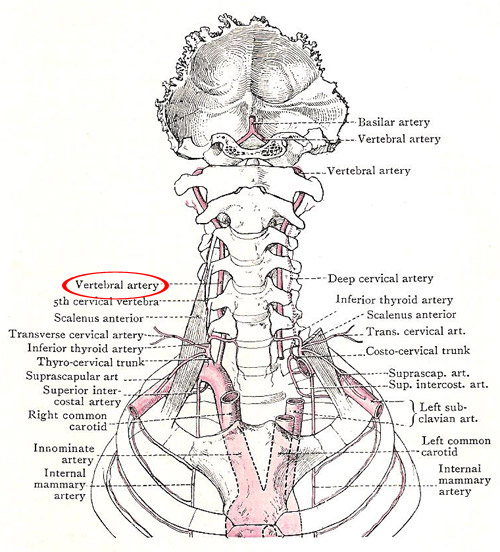vertebral artery

Vertebral artery shown in relation to subclavian arteries and their branches.
A vertebral artery is either of two arteries of the neck which branch from the subclavian arteries and unite to form the basilar artery in a complex called the vertebrobasilar system, which supplies blood to the posterior part of the circle of Willis and thus significant portions of the brain.
Each vertebral artery begins in the root of the neck as a branch of the first part of one of the subclavian artery, and runs upward through the transverse processes of the upper six cervical vertebrae to the base of the skull. It enters the skull through the foramen magnum, and unites with its fellow of the opposite side, at the lower border of the pons, to form the basilar artery. On account of its varying relations it is divided into four parts.
Parts of the vertebral artery
The first part extends from the subclavian artery to the transverse process of the sixth cervical vertebra. The second part begins where the artery enters the transverse processes of the sixth cervical vertebra. It passes vertically upward through the foramina transversaria till it reaches the foramen in the transverse process of the axis vertebra. From that foramen, it runs laterally, as well as upward, to gain the foramen in the transverse process of the atlas, which is placed more laterally.
As the artery emerges on the upper surface of the atlas, the third part begins and curves round the lateral side and the back of the upper articular process of the atlas, in a groove on the upper surface of its posterior arch, and passes under cover of the free, lateral part of the lower margin of the posterior atlantooccipital membrane no become the fourth part.
The fourth part turns upward, pierces the dura mater, and enters the skull through the foramen magnum, in front of the uppermost tooth of the ligamentum denticulatum; then, turning anteromedially, between the hypoglossal nerve above and the first cervical nerve below, it passes to the anterior surface of the medulla oblongata, and, as already stated, joins its fellow of the opposite side at the lower border of the pons.
Vertebral vein
The vertebral vein issues from the aperture in the transverse process of the sixth cervical vertebra. It passes downwards, behind the internal jugular vein, to open into the back of the innominate vein a little below where it starts.


